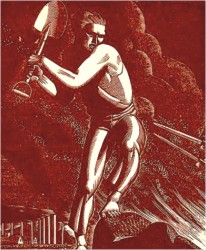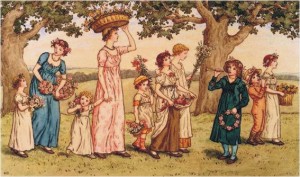Feature
The History and Significance of May Day
Mohammad Shafiqul Islam
 The first day of the month of May is known as May Day. It is the time of year when warmer weather begins and flowers and trees start to blossom. It is said to be a time of love and romance. It is when people celebrate the coming of summer with lots of different customs that are expressions of joy and hope after a long winter. On the other hand it has many more references in history. The first day of the month of May is known as May Day. It is the time of year when warmer weather begins and flowers and trees start to blossom. It is said to be a time of love and romance. It is when people celebrate the coming of summer with lots of different customs that are expressions of joy and hope after a long winter. On the other hand it has many more references in history.
May Day refers to any of several holidays celebrated on this day. May Day also refers to various socialist and labor movement celebrations conducted on May 1, unrelated to the traditional celebrations to commemorate the Haymarket Riot of 1886 and the international socialist movement generally.
 In America, May Day is commonly celebrated as a commemoration of the Haymarket Riot of 1886 in Chicago, Illinois, which occurred on May 4, but was the culmination of labor unrest which began on May 1. The date consequently became established as an anarchist and socialist holiday during the 20th century, and in these circles it is often known as International Workers' Day or Labor Day. In this form, May Day has become an international celebration of the social and economic achievements of the working class and labor movement. May Day has long been a focal point for demonstrations by various socialist, communist, and anarchist groups. On May 3, 1886, police fired into a crowd of strikers killing at least one striker, seriously wounding five or six others, and injuring an undetermined number. In America, May Day is commonly celebrated as a commemoration of the Haymarket Riot of 1886 in Chicago, Illinois, which occurred on May 4, but was the culmination of labor unrest which began on May 1. The date consequently became established as an anarchist and socialist holiday during the 20th century, and in these circles it is often known as International Workers' Day or Labor Day. In this form, May Day has become an international celebration of the social and economic achievements of the working class and labor movement. May Day has long been a focal point for demonstrations by various socialist, communist, and anarchist groups. On May 3, 1886, police fired into a crowd of strikers killing at least one striker, seriously wounding five or six others, and injuring an undetermined number.
The celebration of Labor Day has its origins in the eight hour day movement, which advocated eight hours for work, eight hours for recreation, and eight hours for rest. On 21 April 1856 Stonemasons and building workers on building sites around Melbourne, Australia, stopped work and marched from the University of Melbourne to Parliament House to achieve an eight hour day. Their direct action protest was a success, and they are noted as the first organized workers in the world to achieve an eight hour day with no loss of pay, which subsequently inspired the celebration of Labor Day and May Day.
Due to its status as a celebration of the efforts of workers and the socialist movement, May Day is an important official holiday in Communist countries. In countries other than the United States and Canada, resident working classes fought hard to make May Day an official holiday, efforts which largely succeeded.
 For this reason, in most of the world today, May Day is marked by massive street rallies led by workers, their trade unions, anarchists and various socialist and communist parties. May 1, International Workers' Day, commemorates the historic struggle of working people throughout the world, and is recognized in most countries. For this reason, in most of the world today, May Day is marked by massive street rallies led by workers, their trade unions, anarchists and various socialist and communist parties. May 1, International Workers' Day, commemorates the historic struggle of working people throughout the world, and is recognized in most countries.
In 1884, the Federation of Organized Trades and Labor Unions of the United States and Canada passed a resolution which asserted that “eight hours shall constitute a legal day's work from and after May 1, 1886, and that we recommend to labor organizations throughout this district that they so direct their laws as to conform to this resolution”. The following year the Federation repeated the declaration that an eight-hour system was to go into effect on May 1, 1886. With workers being forced to work ten, twelve, and fourteen hours a day, support for the eight hour movement grew rapidly. In the months prior to May 1, 1886, thousands of workers, organized and unorganized, were drawn into the struggle. Chicago was the main center of the agitation for a shorter day. The anarchists were in the forefront of the Central Labor Union of Chicago, which consisted of 22 unions in 1886, among them the seven largest in the city.
The meeting proceeded without incident, and by the time the last speaker was on the platform, the rainy gathering was already breaking up, with only about two hundred people remaining.
It was then a police column of 180 men marched into the square and ordered the meeting to disperse. At the end of the meeting a bomb was thrown at the police, killing one instantly, six others died later. About seventy police officers were wounded. Police responded by firing into the crowd. How many civilians were wounded or killed from police bullets never was ascertained exactly. Although it was never determined who threw the bomb, the incident was used as an excuse to attack anarchists and the labor movement in general.
Police ransacked the homes and offices of suspected radicals, and hundreds were arrested without charge. A reign of police terror swept over Chicago. Staging 'raids' in the working-class districts, the police rounded up all known anarchists and other socialists. “Make the raids first and look up the law afterward!” publicly counseled the state's attorney. Anarchists in particular were harassed, and eight of Chicago's most active were charged with conspiracy to murder in connection with the Haymarket bombing. One of the laborers committed suicide in prison. The authorities turned over the bodies to friends for burial, and one of the largest funeral processions in Chicago history was held.
It is not surprising that the state, business leaders, mainstream union officials, and the media would want to hide the true history of May Day. Nevertheless, rather than suppressing the labor and anarchist movements, the events of 1886 and the execution of the Chicago anarchists, spokesmen of the movement for the eight hour day, mobilized many generations of radicals. As workers, everyone must recognize and commemorate May Day not only for its historical significance, but also as a time to organize around issues of vital importance to the working-class, i.e. the people, of today.
One of the famous radical song writers of the world Joe Hill (1879-1915) who was a Swedish composed a song for the workers of the world:
Workers of the world, awaken!
Rise in all your splendid might
Take the wealth that you are making,
It belongs to you by right.
No one will for bread be crying
We'll have freedom, love and health,
When the grand red flag is flying
In the Workers' Commonwealth.
I would like to relate an incident which I have recently experienced to the great May Day as it may bring scruples to the corrupt political leaders of Bangladesh, some of whom are smiling villains.
I happened to experience a hair-raising incident in the bus recently when I was on the way to Sakhipur, Tangail from Dhaka. I was making a journey the whole day long as I was going home from Sylhet. The bus reached Gurai, Mirzapur, Tangail where a number of passengers many of whom were women, worn-out, got on the bus. There was little space for standing let alone sitting in the bus. But all the passengers there, both men and women, made a tug of war to have a meager space at any cost. I was feeling perturbed and annoyed; nevertheless, I had a soft corner for the distressed passengers as they, perhaps, had no alternatives to go home.
All the female passengers who were standing held the rod of the bus tightly so as to escape falling as the bus was moving along the zigzag road.
Being sentient to the jam-packed situation in the bus, I turned to the standing passengers who, as I could see, were looking exhausted, fatigued and very worried too.
It seemed that they were to fly to their destination for the reason, may be, it was about 9 pm. The driver of the bus had to put on the brake abruptly now and then for the worse condition of the road and so they were to bend forward and then stand motionless.
I have not that paranormal language to delineate the reality into words.
I was touched at seeing such deplorable state of women. This cruel scenario added a new experience on the afflictions of the female working class of Bangladesh. It was more astounding that they were having some discussions sometimes making laughter among themselves. When a woman giggled loudly, I gave attention to her. She seemed to regret and uttered “Amgo koshter shima nai gou; Tai hashi. Hashle koshtota ektu bhuila thakon jay. Kisu mone koirenna bhaijan (We try to forget our sorrows by smiling in such a way).” To my queries those women replied that they go to garments at 8 am, arrive home at 9 pm and are paid taka 1000-1200 in return of working for 30 days a month.
This is the real picture of the female workers in Bangladesh. They are not respected well or attended to by the concerned people. I yearn May Day 2007 will bring conscience to the affluent in Bangladesh. May the working class of our country as well as of the whole world rest in peace.
Lecturer, Department of English
Metropolitan University, Sylhet
E-mail: msijewel@gmail.com
|
